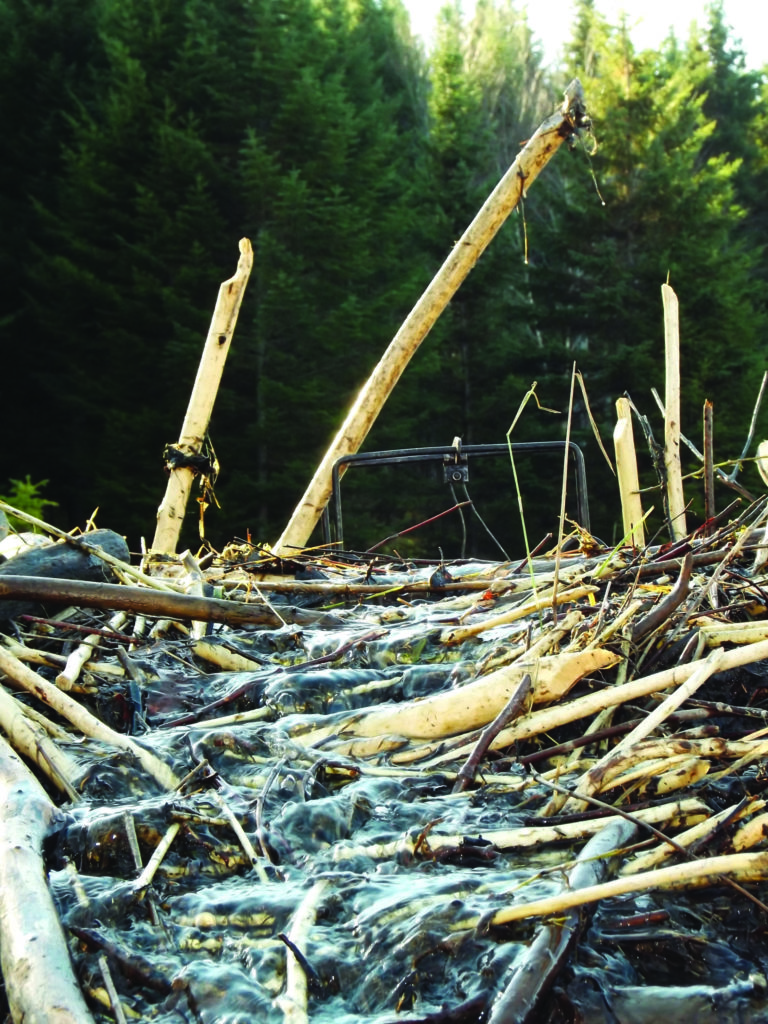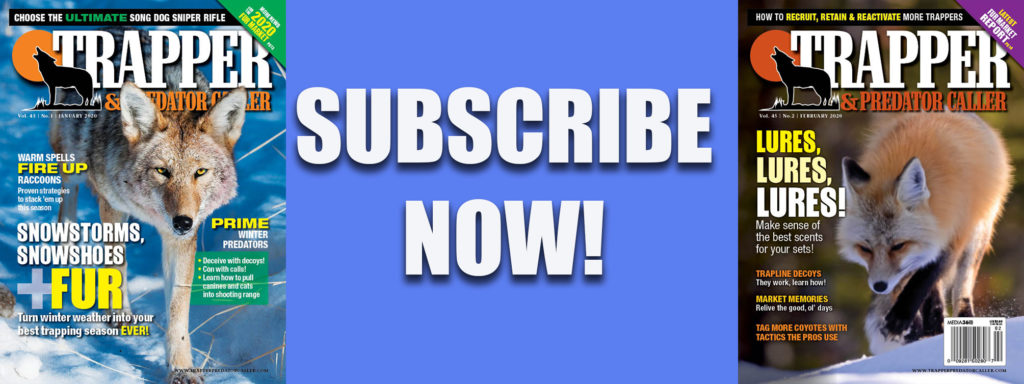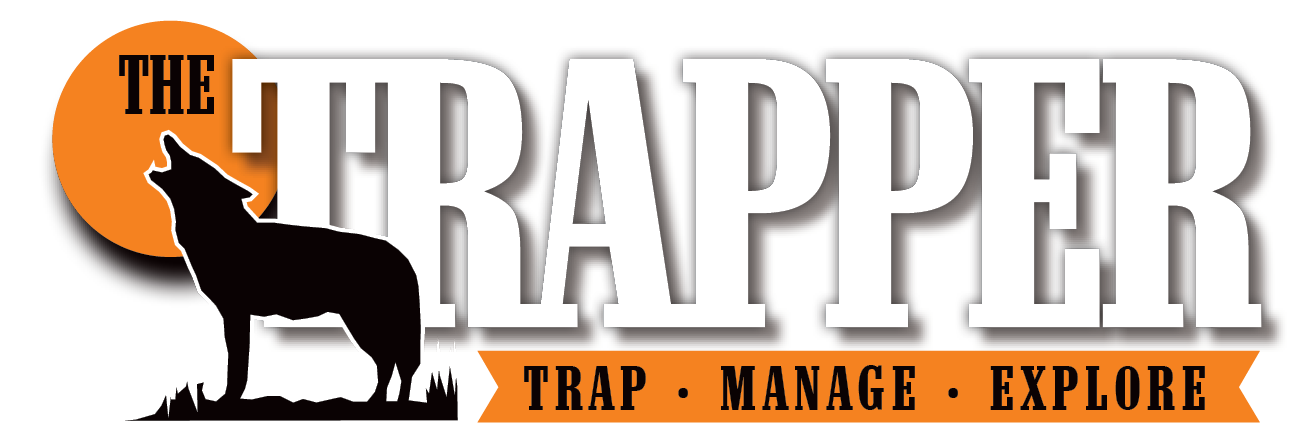How to use materials found in nature to enhance your sets.
By Cary Rideout / Photo by Lorain Ebbett-Rideout
For some reason we trappers like to mess with nature hoping to improve on things. How many times have you decided major landscaping will bring every pelt in the county to your sets? Breaking out the earth moving equipment you excavate until the site looks like a home improvement project gone wrong. It might be soil conditions, high water or just the wrong place but we strap on the stubborn hat certain a few more adjustments will be just right. Most times if we only worked with nature and kept things as we found them fur might run towards the set instead of away.

#12. Ready For Fur
Any effective trap set must fit with the environment and successfully guide the target into the trap. A tough set of requirements made tougher by all the potential disasters any trapping situation has. If something about the trap site looks amiss then the target is put on edge and beings to feel suspicious. One of the real keys to putting fur on the boards is to keep the surroundings simple as possible so the fur target will be concentrating on the attraction not what’s around it. Subtly is easy to achieve if you work with the terrain not trying to be heavy-handed. Think about how a fox steps so dainty or a cat pussyfoots along. They don’t want step on something that might injure their feet. Old Ringtail is less careful but even a coon won’t step onto sharp rocks. Use this instinct and work a few tough weed stalks or coarse grass into trap sets. A clump of rough grass looks natural and the fur bearer can see over it to keep an eye on the surrounding country. Big clumps of golden rod, raspberry canes or a similar plant work great just slash the butts at an angle and force them into the ground. Heavy brush is fine but I like weeds as they don’t interfere with the catch or damage fur as prickly scrub might. And it’s subtler.
Sticks, Stones And Snow
When setting traps nature usually has supplied all the materials we might need to guide fur into the sets. Sticks or stones are old favorites but stones can be a troublesome sort of natural object. A rolling stone is fine for lawn bowls but a stone that has any tipsiness is a disaster waiting to happen. I’m not discounting rocks and they are part of my trapline but you need to have them solid. Dig a bit of a foundation if the stone seems wobbly. Use a large enough stone to get the wanted reaction but don’t build a wall of small stuff if you can avoid it. Any piled up stones can be toppled so keep things low and natural. Finally always be sure you use firm flat stone for the loose jaws that will stay in place. I spent many a trapping season figuring that one out.
Stones aren’t the only natural choice for trappers. Lumps of sod can be a better direction device and will stand up to a misplaced foot. I’ve piled low banks of snow along streams as a guide and used ice chunks as well. They work, look natural and have no scent. But snow and ice both can shift and melt on a sunny December afternoon. If using snow or ice, first make a substructure of limbs and then add the frozen stuff in case things warm up.
A few stakes at a water set can be a way to work a beaver or mink into a trap but be careful with this technique. Years ago many trappers used baited sets or dam crossovers with stake walls set close and tight. It worked but did it ever look like an Old West fort! Better to randomly angle old beaver sticks in different directions because nature has no pattern and neither does a smart trapper. Use different sizes and don’t make things neat. Same goes for staking around a bucket or box. A single rough weed or pencil size piece of brush on either side to guide is plenty. Don’t build a runaway for a bucket, just keep it loose and natural.
Don’t Fear the Rust
If you ever want to stir up a heated discussion about being natural, toss the stained vs unstained trap debate out on the cabin floor and watch the fun. It always a surprise to hear from a super careful trapper who is conscious of every footprint, casually toss a well-rusted coil spring down. They laugh at trap treatment certain that a natural rusty scent is fine. Of course the polar opposite you encounter is the unconcerned trapper who works with bare hands, spattering human scent everywhere but is clinically careful about trap dipping. Whether it’s a petroleum dip or Uncle Frank’s Adirondack bark boil they work themselves into a lather preparing their steel. So what is less likely to make a fox turn tail? Is rust the deal breaker most trappers today believe?
For a good chunk of my formative years I bounced over rocky farm fields on spring tractor seats. Hours in those metal saddles were pretty boring but it allowed me to study all the tracks and trails of farmland fur bearers. One thing I noticed real fast was fur didn’t seem too upset by machinery smells or even man tracks. Just about anything with four feet would snoop around any place I happen to spin a wheel or dig up the ground. So which is more natural, a trap that smells like a rusty bumper or one that smells like pine-scented paraffin? Personally I dip every couple years unless a trap is really grungy. Snares receive no treatment other than being stored in a pail with dry hemlock bark. But you see, I live an uncomplicated natural life.
Trees & Trickles
Watch what you use for a snare pole or brush drag. To save time I once cut a bundle of snare poles and hauled them to the snare sites. “Oh you’re smart Rideout,” I thought but after repeated refusals I had to rethink my methods. To this dumb human any tree looks natural so what had the fur so suspicions? A leaning pole or duck under always did work and it took a few inches of snow to understand what was happening. Many of the slender snare poles were yellow birch and the refusals were in a section with no such trees. The yellow poles stuck out like a glaring red stop sign. It seemed sort of obvious but like many natural things I overlooked it and it cost.
Another point to remember in your quest for natural is don’t set all your snare poles at the same angle. Stop and look around the woods noting if there are a large number of blow downs or naturally leaning trees. Take note and follow the natural trend whatever it is. If the forest is covered with leaners, go heavy on duck-under poles. In tall straight timber use drag poles set the same. A random odd-looking pole might require a long extension so it doesn’t look out of place. But don’t get into a pattern, either. Mix things up because random is part of nature. Same goes for your guiding material. Remember to be subtle and don’t force with too many unsettling sticks. Less is always more in snaring situation and it will look more real too.
Water sets don’t usually require too much fussing but once you start it’s tough to stop. I tried for a whole season to work a #280 into a narrow brook and practically rerouted the waterway before I was done. The wandering otters I knew traveled up the brook were on a two-week rotation and despite major alterations, I never could get things looking natural enough to fool a single pelt. The brook was twisty and narrow not much wider than the 8×8 trap but low banks and diamond-hard bottom should have been a clue. Unable or unwilling (you choose) to find a decent site it was clear that alterations were in order. Low water flow meant barely half the body grip was submerged so I draped weeds over the trap frames that of course shouted, hey look at the trap you otters! I could see it a hundred yards away and you can bet they did as well. A low rock wall was equally odd looking and even a dry spruce duck-under pole stood out. After lugging in a wide assortment of landscaping materials I pulled all the traps after a snowfall that made my sets look like the loud lumps they were. Sometimes if you can’t work with nature ignore your ego and move along.
Natural Aromatics
When it comes to choosing a natural scent sure to calm the spookiest furbearer, hands down tangy spruce and fragment skunk are right up there. I love skunk scent pure and potent and actually don’t find it all that upsetting. Skunk is about as natural as you can possibly get and convinces the uninterested to beat a hasty advance. In all honesty, it is the workhorse on my trap line and I can’t come up with much it won’t fix. As a cover scent or convincer of the reluctant, it never fails but be careful and treat it like nitroglycerin! You can’t buck the odds forever and sooner or later the house is gonna win. All the mustelids, the canines and cats are drawn to skunk like the neighbours to a free BBQ. Skunk is a step to simplifying your trapline as it serves so many purposes and it keeps in working condition all season. But always be sure to buy pure skunk essence, not skunk lure.
Spruce is part of the woods I trap and its strong natural scent can cover a multitude of scent issues for the trapper. Steel stored in a fresh bed of boughs is perfect for finishing any trap treatment. Hands or gloves wiped repeatedly are masked with this powerful cover smell. A few boughs underfoot at a trap site are as good as any sanitized setting cloth and reusable, too. Spruce is much like skunk and lingers long after it should dissipate. And along with being natural, spruce is free and at your fingertips. About the only downside is pitch. Don’t allow cut ends anywhere near steel, tools or hands. Avoid contact with spruce cones as well which can be very pitchy too. Spruce pitch is about like tar and miserable once stuck to something you don’t want it to be. Always treat both these wonderful scents with care because nature can be stinky and sticky.
The Dirty Truth
Soil plays a big part in many trapping operations. We gather soil in the form of ant hill dust, old stump or forest duff and even have special blends to work with. But a fellow has to be cautious of soils and they don’t always look as though they belong where we spread them. I was working lured dirt holes along a section of farm roads one autumn and the weather was up to its usual tricks with rain followed by freeze in equal amounts. I would dig under or around the traps after each deluge and work up some of the deep dry soil to add fluff to the sets. Well, I didn’t catch any fur but I did have numerous four footed visits, just no takers. Finally one rainy morning I approached the sets and like a lightning bolt I realized my problem. The deep dug soil was radically different in color after it was exposed. Could this be the problem? Maybe, but being late in the season the ground soon froze deep so I switched to snares. Since then I am much more cautious about soil when trying to blend in with nature.
It’s popular these days to talk about things being natural and not artificial or manmade. Trapping in many ways is the same we all try to set our steel so things look as natural as possible. But what looks natural to a harried trapper and an ever alert furbearer can be very different.

